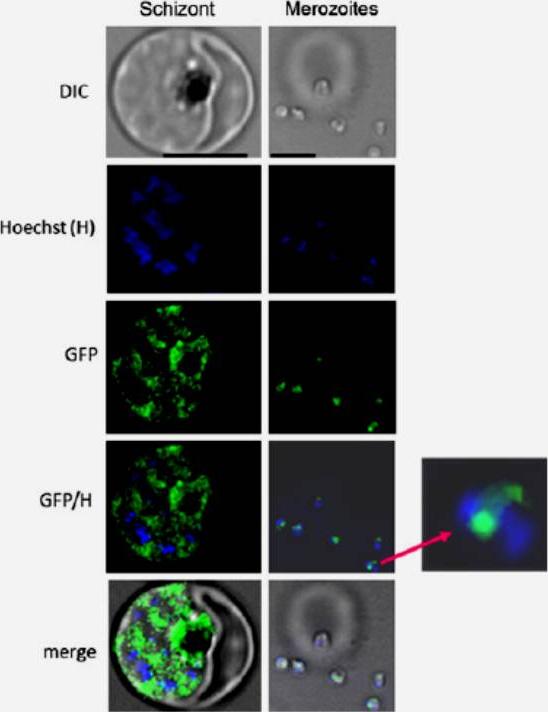PCHAS_1366700 tyrosine kinase-like protein, putative (TKL3)
Disruptability [+]
| Species | Disruptability | Reference | Submitter | |
|---|---|---|---|---|
| P. berghei ANKA |
Possible |
RMgm-1221 | Imported from RMgmDB | |
| P. berghei ANKA |
Refractory |
RMgm-572 | Imported from RMgmDB | |
| P. berghei ANKA |
Possible |
PlasmoGEM (Barseq) | PlasmoGEM | |
| P. falciparum 3D7 |
Refractory |
22127061 | Theo Sanderson, Wellcome Trust Sanger Institute | |
| P. falciparum 3D7 |
Possible |
USF piggyBac screen (Insert. mut.) | USF PiggyBac Screen | |
Mutant phenotypes [+]
| Species | Stage | Phenotype | Reference | Submitter |
|---|---|---|---|---|
| P. berghei ANKA | Asexual |
No difference |
RMgm-1221 | Imported from RMgmDB |
| P. berghei ANKA | Asexual |
Attenuated |
PlasmoGEM (Barseq) | PlasmoGEM |
Imaging data (from Malaria Metabolic Pathways)

Visualisation of GFP-tagged PfTKL3 in asexual parasites. Live asexual cultures from the GFP-tagged line were observed by fluorescence microscopy. A signal was detected only in the schizont and free merozoites. A typical image is shown for both these stages. A 49 relative enlargement of a merozoite is shown to the right. Scale bar: 5 mm. GFP signal was detected in schizonts and free merozoite. No signal was detected in rings and trophozoites. In schizonts, the signal seems to be confined within the parasite (implying the putative PEXEL is not functional) and to localise within structures forming a network that becomes extensive in mid and late schizont stages. In free merozoites, the protein appears to be localised in an elongated structure with bulbous ends (see the enlarged merozoite).Abdi A, Eschenlauer S, Reininger L, Doerig C. SAM domain-dependent activity of PfTKL3, an essential tyrosine kinase-like kinase of the human malaria parasite Plasmodium falciparum. Cell Mol Life Sci. 2010 67:3355-69. :
See original on MMPMore information
| PlasmoDB | PCHAS_1366700 |
| GeneDB | PCHAS_1366700 |
| Malaria Metabolic Pathways | Localisation images Pathways mapped to |
| Previous ID(s) | PC000151.03.0, PC000943.01.0, PC001318.02.0, PC301072.00.0, PCAS_136670, PCHAS_136670 |
| Orthologs | PBANKA_1362100 , PF3D7_1349300 , PKNH_1251600 , PVP01_1205500 , PVX_083360 , PY17X_1367800 |
| Google Scholar | Search for all mentions of this gene |